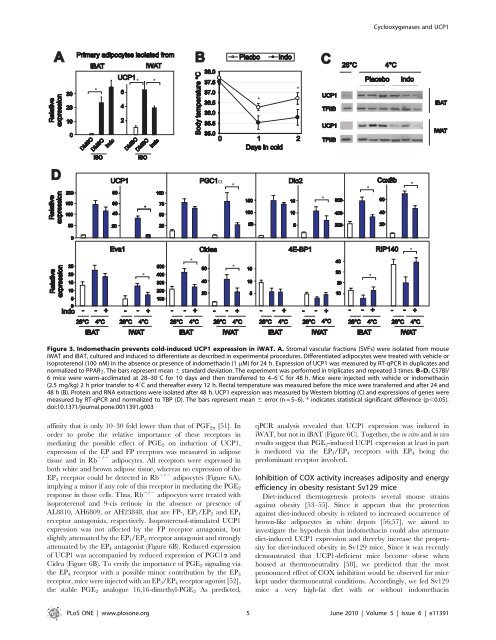The obesogenic effects of polyunsaturated fatty acids are dependent ...
The obesogenic effects of polyunsaturated fatty acids are dependent ...
The obesogenic effects of polyunsaturated fatty acids are dependent ...
You also want an ePaper? Increase the reach of your titles
YUMPU automatically turns print PDFs into web optimized ePapers that Google loves.
Cyclooxygenases and UCP1<br />
Figure 3. Indomethacin prevents cold-induced UCP1 expression in iWAT. A. Stromal vascular fractions (SVFs) were isolated from mouse<br />
iWAT and iBAT, cultured and induced to differentiate as described in experimental procedures. Differentiated adipocytes were treated with vehicle or<br />
isoproterenol (100 nM) in the absence or presence <strong>of</strong> indomethacin (1 mM) for 24 h. Expression <strong>of</strong> UCP1 was measured by RT-qPCR in duplicates and<br />
normalized to PPARc. <strong>The</strong> bars represent mean 6 standard deviation. <strong>The</strong> experiment was performed in triplicates and repeated 3 times. B–D. C57Bl/<br />
6 mice were warm-acclimated at 28–30uC for 10 days and then transferred to 4–6uC for 48 h. Mice were injected with vehicle or indomethacin<br />
(2.5 mg/kg) 2 h prior transfer to 4uC and thereafter every 12 h. Rectal temperature was measured before the mice were transferred and after 24 and<br />
48 h (B). Protein and RNA extractions were isolated after 48 h. UCP1 expression was measured by Western blotting (C) and expressions <strong>of</strong> genes were<br />
measured by RT-qPCR and normalized to TBP (D). <strong>The</strong> bars represent mean 6 error (n = 5–6). * indicates statistical significant difference (p,0.05).<br />
doi:10.1371/journal.pone.0011391.g003<br />
affinity that is only 10–30 fold lower than that <strong>of</strong> PGF 2a [51]. In<br />
order to probe the relative importance <strong>of</strong> these receptors in<br />
mediating the possible effect <strong>of</strong> PGE 2 on induction <strong>of</strong> UCP1,<br />
expression <strong>of</strong> the EP and FP receptors was measured in adipose<br />
tissue and in Rb 2/2 adipocytes. All receptors were expressed in<br />
both white and brown adipose tissue, whereas no expression <strong>of</strong> the<br />
EP 3 receptor could be detected in Rb 2/2 adipocytes (Figure 6A),<br />
implying a minor if any role <strong>of</strong> this receptor in mediating the PGE 2<br />
response in those cells. Thus, Rb 2/2 adipocytes were treated with<br />
isoproterenol and 9-cis retinoic in the absence or presence <strong>of</strong><br />
AL8810, AH6809, or AH23848, that <strong>are</strong> FP-, EP 1 /EP 2 and EP 4<br />
receptor antagonists, respectively. Isoproterenol-stimulated UCP1<br />
expression was not affected by the FP receptor antagonist, but<br />
slightly attenuated by the EP 1 /EP 2 receptor antagonist and strongly<br />
attenuated by the EP 4 antagonist (Figure 6B). Reduced expression<br />
<strong>of</strong> UCP1 was accompanied by reduced expression <strong>of</strong> PGC1a and<br />
Cidea (Figure 6B). To verify the importance <strong>of</strong> PGE 2 signaling via<br />
the EP 4 receptor with a possible minor contribution by the EP 3<br />
receptor, mice were injected with an EP 3 /EP 4 receptor agonist [52],<br />
the stable PGE 2 analogue 16,16-dimethyl-PGE 2 As predicted,<br />
qPCR analysis revealed that UCP1 expression was induced in<br />
iWAT, but not in iBAT (Figure 6C). Together, the in vitro and in vivo<br />
results suggest that PGE 2 -induced UCP1 expression at least in part<br />
is mediated via the EP 3 /EP 4 receptors with EP 4 being the<br />
predominant receptor involved.<br />
Inhibition <strong>of</strong> COX activity increases adiposity and energy<br />
efficiency in obesity resistant Sv129 mice<br />
Diet-induced thermogenesis protects several mouse strains<br />
against obesity [53–55]. Since it appears that the protection<br />
against diet-induced obesity is related to increased occurrence <strong>of</strong><br />
brown-like adipocytes in white depots [56;57], we aimed to<br />
investigate the hypothesis that indomethacin could also attenuate<br />
diet-induced UCP1 expression and thereby increase the propensity<br />
for diet-induced obesity in Sv129 mice. Since it was recently<br />
demonstrated that UCP1-deficient mice become obese when<br />
housed at thermoneutrality [58], we predicted that the most<br />
pronounced effect <strong>of</strong> COX inhibition would be observed for mice<br />
kept under thermoneutral conditions. Accordingly, we fed Sv129<br />
mice a very high-fat diet with or without indomethacin<br />
PLoS ONE | www.plosone.org 5 June 2010 | Volume 5 | Issue 6 | e11391
















